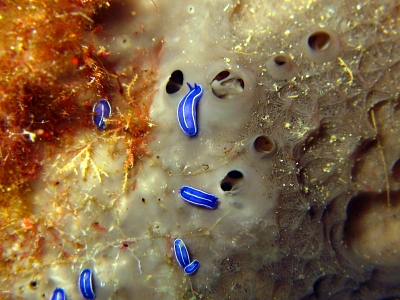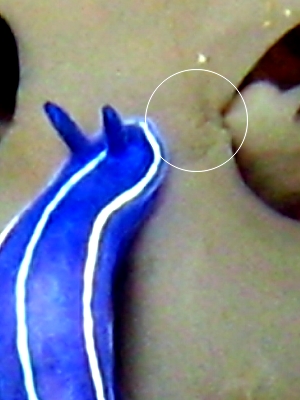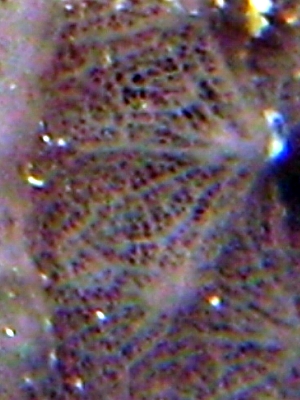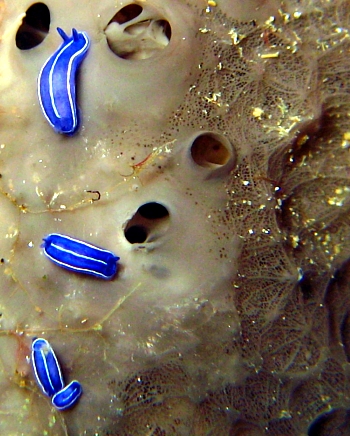Re: Feeding in Hypselodoris orsinii
October 15, 2008
From: Dominique Horst

Concerning message #7384:
Hi Bill,
I've identified these blue chromodorids as Hypselodoris orsinii, and following Jean-Pierre Bielecki advice search for the tubercles, that are visible, with difficulties.
These animals are feeding, and I suppose that traces that are visible are left by their radula ....
Locality: Bagaud Island, 12 m, France, Mediterranean sea, 11 November 2008. Length: 4-5 mm. Photographer: Dominique Horst.
Kind regards,
Dom.
dominique.horst@wanadoo.fr



Dear Dom,
Thanks very much for these great photos. Yes this is Hypselodoris orsinii. One other way to identify it is from the sponge it is feeding on. Of the more than 40 species of Hypselodoris I have information on, all feed on sponges of the family Dysideidae except for two. One of these, H. bennetti, feeds on a species of Psammocinia (Fam: Irciniidae), and the other, H. orsinii, feeds on sponges of the Family Thorectidae. At present the literature suggests it feeds on both Cacospongia mollior and Scalarispongia scalaris, but as all the photos on the Forum [#7384, #11147, #7305, Fact Sheet] have been identified as Scalarispongia by Dr Bergquist, who is the world expert on the family, it makes me wonder if the literature records for Cacospongia mollior are misidentifications, as the two species are difficult to separate externally, and Scalarispongia scalaris was previously considered a species of Cacospongia.
I have not shown your photos to Dr Bergquist but I am pretty sure the sponge is Scalarispongia scalaris. One of the features of the genus is the way the secondary bundles of fibres in its skeleton are arranged in a regular ladder-like structure, which we can see in the close-up I have included. Why H. orsinii is the only species of the genus to feed on a thorectid sponge rather than a dysideid, is a mystery, as their are other species of Hypselodoris in the Mediterranean and they find dysideid sponges living their quite palatable. Perhaps H. orsinii will turn out to be unrelated to other Mediterranean species of Hypselodoris or perhaps it is an adventurous species beginning a new branch of Hypselodorisevolution.
-
Cook, S. de C. & Bergquist, P.R. (2000) Two new genera and five new species of the "Cacospongia" group (Porifera, Demospongiae, Dictyoceratida). Zoosystema, 22(2): 383 - 400.
-
Cook, S. D. C. & Bergquist, P. R. (2002). Family Thorectidae Bergquist, 1978. pp. 1028-1050 [In] Hooper, J.N.A. & Soest, R.W.M. Van (eds) Systema Porifera. A guide to the classification of sponges. New York, Boston, Dordrecht, London, Moscow: Kluwer Academic/Plenum Publishers Vol. 1
-
Rudman, W.B. & Bergquist, P.R. (2007) A Review of feeding specificity in the sponge-feeding Chromodorididae (Nudibranchia: Mollusca). Molluscan Research, 27(2): 60-88
Best wishes,
Bill Rudman
Related messages
-
Re: Hypselodoris orsinii from Croatia
From: Adam Petrusek, October 8, 2003 -
Hypselodoris orsinii from Croatia
From: Adam Petrusek, October 7, 2003 -
Hypselodoris coelestis from the Mediterranean
From: Nicolas, March 18, 2003 -
How to recognise Hypselodoris orsinii
From: Jean-Pierre Bielecki, June 29, 2002 -
Feeding in Hypselodoris orsinii
From: Jean-Pierre Bielecki, June 29, 2002 -
Re: Hyps. orsinii from French Mediterranean
From: Marina Poddubetskaia , June 26, 2002 -
Re: Hypselodoris orsinii from French Mediterranean
From: Alma Sánchez, June 25, 2002 -
Hypselodoris orsinii from French Mediterranean
From: Marina Poddubetskaia, June 24, 2002 -
Hypselodoris orsinii? from Turkey
From: Baki Yokes, September 28, 2001
